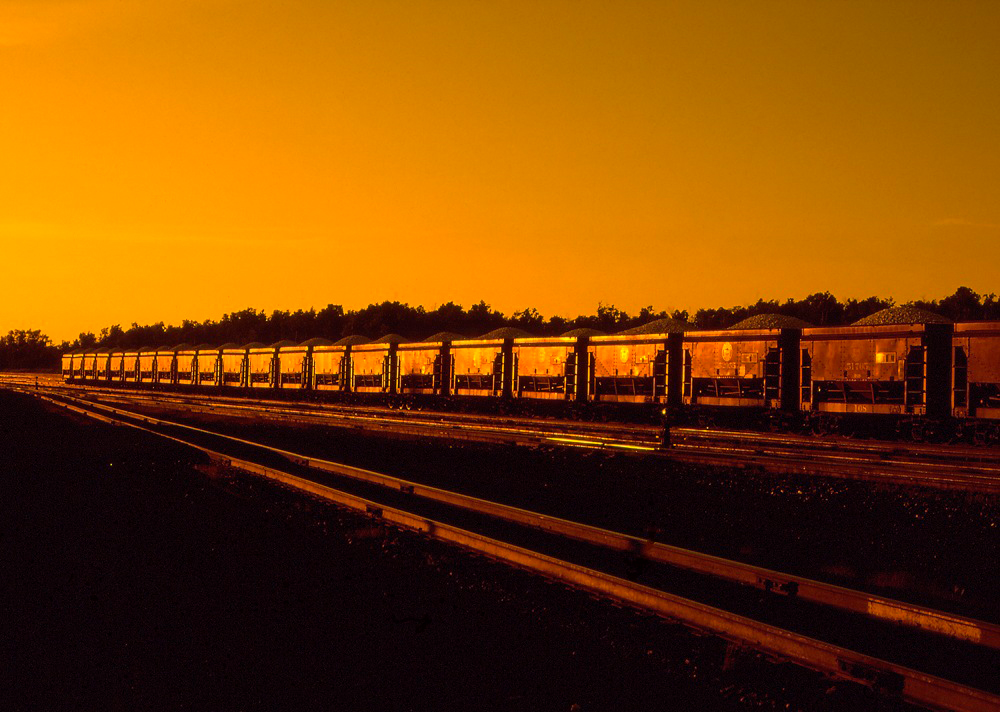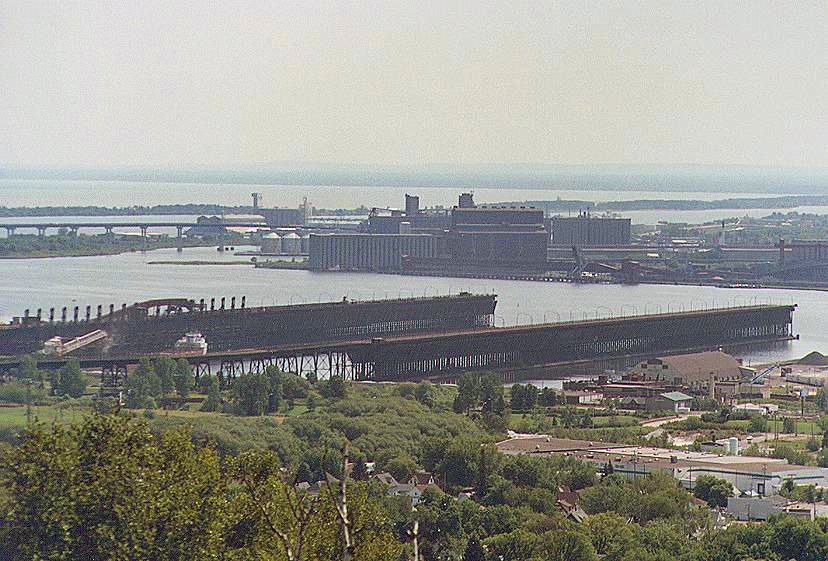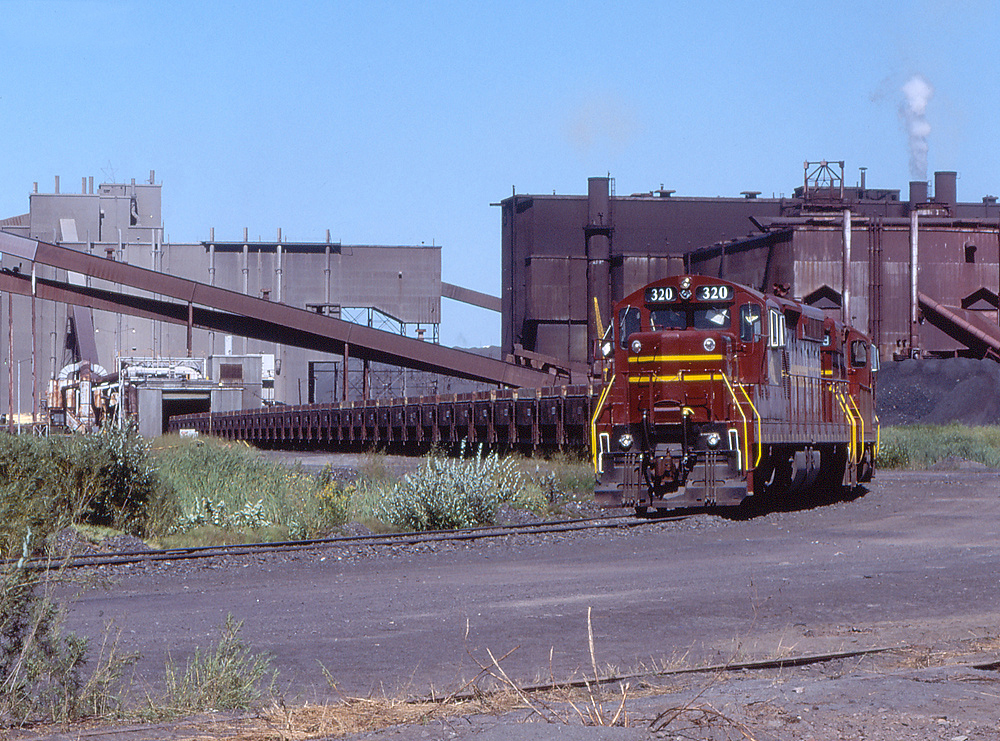Iron Ore Rail Cars: A History Of The Classic 'Jennie'
Last revised: August 29, 2024
By: Adam Burns
Iron ore cars, better known as simply ore jennies, are a specialized type of hopper car designed exclusively to haul heavy loads of iron ore.
The car's history can trace its roots back to the mid-1800s although as Mike Schafer notes in his book, "Freight Train Cars," it wasn't until the end of that century when vast veins of ore were discovered in the Upper Midwest did the car become a common sight.
Notable carries such as the Milwaukee Road, Chicago & North Western, Soo Line, and especially the Duluth, Missabe & Iron Range all handle considerable amounts of ore and derived a significant portion of the revenue from such.
Today, despite a sharp decrease in domestic production jennies can still be found in service.
 The last light of a late summer's day is cast over loaded ore jennies at Missabe's yard in Proctor, Minnesota on August 15, 1994. Wade Massie photo.
The last light of a late summer's day is cast over loaded ore jennies at Missabe's yard in Proctor, Minnesota on August 15, 1994. Wade Massie photo.The ore jenny, sometimes referred to simply as an ore car, was born largely out of need to more efficiently maximize a hopper's space.
This particular product could just as easily be hauled in the standard hopper normally assigned in coal service. However, because ore is so much more dense a hopper can only be partially filled before its weight limit is reached.
In some cases railroads continued to move ore in this fashion, even through the postwar period, providing the odd scene of a "loaded" 50 or 75-ton hopper only half full.
The jenny solved this problem as it was much shorter, in both length and height, than its larger cousin but was otherwise identical in operation featuring bottom-fed chutes (usually one or two) in which ore could quickly be unloaded.
While it is unknown exactly when the first jennies entered service it is believed they began appearing during the mid-19th century when the first iron mines entered production.
John White, Jr. notes in his book, "The American railroad Freight Car," the earliest known cars ever used were plucked from the Trent River (Ontario) in 1981 and appear to date to around 1860.
The nation's first iron ore road, the Duluth, South Shore & Atlantic, began operations around Marquette, Michigan in 1860.
While it is not known when the company experimented with a specialized ore jenny it can surmised it probably occurred sometime soon after it opened.
During the Civil War era iron ore mines could be found throughout the eastern United States; it was prolific throughout the Appalachians although was a relatively low-grade product that was not particularly profitable.
The first recorded ore cars placed into service were built by the legendary Virginia & Truckee in 1869 by the railroad's shops and the Risdon Iron Works.
The iron-built, two-axle cars were 8 feet 8 inches long by 8 feet wide and could haul 8 tons of gold or silver ore.
Naturally, as the iron ore trade drastically increased when vast amounts of high-grade iron were discovered in Michigan's Upper Peninsula and northern Wisconsin during the 1840s and 1850s (as well as parts of Minnesota between 1866 and 1904), jennies became increasingly larger in size and could handle evermore tonnage.
Most mining operations here began appearing after 1870, coinciding with the widespread use of the ore jenny, which was also around the time the American steel industry blossomed.
For instance, the Chicago & North Western had over 4,000 jennies in service by August, 1881, a month in which it hauled 270,000 tons of ore.
Iron is a key component in the production of steel and railroads were poised to reap the profits from moving this commodity to new mills in places such as Pittsburgh, parts of Ohio, and the Upper Ohio Valley.
The first ore jennies were rather small designs and as Patrick Dorin points out in his book, "An Illustrated Guide To American Freight Train Equipment," since they were constructed primarily of wood could only handle about 30 tons of product.
As iron and steel became widely used in car construction during the early 1900s jennies, along with most other freight equipment, grew in size to 50 tons, 70 tons, and eventually 75 tons.
Today, the car hauls anywhere between 85 to 100 tons and newer models are nearly identical in appearance to standard hoppers only slightly smaller in length.
 A bird's-eye view of the harbor at Duluth, Minnesota features Missabe's Dock #6 (left) and Dock #5 (right, unused since the 1970's) on August 12, 2006. Doug Kroll photo.
A bird's-eye view of the harbor at Duluth, Minnesota features Missabe's Dock #6 (left) and Dock #5 (right, unused since the 1970's) on August 12, 2006. Doug Kroll photo.To understand just how dense ore is in comparison to coal or aggregates a jenny built during the postwar period was around 24 feet in length (measured coupler to coupler) with a capacity, as previously mentioned, between 50 to 75 tons.
By comparison, a hopper carrying the same tonnage was much longer, usually between 40 to 50 feet.
Mr. Dorin goes on to note that the 24-foot design became an industry standard since the car fit quite well on an ore dock which utilized dumping pockets (used to load water-going freighters) that were 12 feet in length. If the train of jennies was placed just right, every other car could be spotted for unloading.
Once these initial pockets were filled the entire consist was shifted to load the remaining unfilled pockets. While it may not appear so it was actually a very efficient operation.
Today, such ore docks can still be found in service but new operations often utilize car dumpers instead. During the iron industry's peak years most railroads serving the Upper Midwest all operated their own docks along the Great Lakes such as:
- Great Northern at Superior, Wisconsin
- Milwaukee Road and Chicago & North Western at Escanaba, Michigan
- Wisconsin Central/Soo Line at Ashland, Wisconsin
- Duluth, Missabe & Iron Range at Duluth, Minnesota
Additionally, there were numerous ore docks located in the state of Ohio at locations such as:
- Cleveland
- Huron
- Toledo
- Lorain
- Ashtabula
- Conneaut
These docks were operated by railroads like the Pennsylvania, Bessemer & Lake Erie, Wheeling & Lake Erie, New York Central, and Baltimore & Ohio for transporting iron to steel mills located in West Virginia, Ohio, and Pennsylvania.
 Missabe SDM #320 and another unit work the Fairlane Plant at Forbes, Minnesota on August 15, 1994. Wade Massie photo.
Missabe SDM #320 and another unit work the Fairlane Plant at Forbes, Minnesota on August 15, 1994. Wade Massie photo.With the United States steel industry a mere shell today of what it was only 30 to 40 years ago the need for iron, and ore jennies to transport it, has dropped dramatically.
However, loads of taconite still roll over the nation's rails and can be found in service on BNSF and Canadian National (after the latter acquired DM&IR in 2004). You can also find ore moving over CSX and Norfolk Southern.
Despite the great decrease in production over the years, as long as portions of the Upper Midwest continue to provide rich seams of iron there will most likely always remain at least a few ore jennies rolling along in service around the country.
Recent Articles
-
New York Dinner Train Rides In The Adirondacks!
Jan 05, 26 09:45 PM
Operating over a restored segment of the former New York Central’s Adirondack Division, the Adirondack Railroad has steadily rebuilt both track and public interest in passenger rail across the region. -
Ohio Dinner Train Rides On The CVSR!
Jan 05, 26 08:32 PM
While the railroad is well known for daytime sightseeing and seasonal events, one of its most memorable offerings is its evening dining program—an experience that blends vintage passenger-car ambience… -
Pennsylvania's - Wine Tasting - Train Rides
Jan 05, 26 01:08 PM
Wine tasting trains are a unique and enchanting way to explore the state’s burgeoning wine scene while enjoying a leisurely ride through picturesque landscapes. -
West Virginia - Wine Tasting - Train Rides
Jan 05, 26 01:02 PM
West Virginia, often celebrated for its breathtaking landscapes and rich history, offers visitors a unique way to explore its rolling hills and picturesque vineyards: wine tasting trains. -
Virginia - Wine Tasting - Train Rides
Jan 05, 26 12:58 PM
Wine tasting trains in Virginia provide just that—a unique experience that marries the romance of rail travel with the sensory delights of wine exploration. -
Utah - Wine Tasting - Train Rides
Jan 05, 26 12:37 PM
Utah, a state widely celebrated for its breathtaking natural beauty and dramatic landscapes, is also gaining recognition for an unexpected yet delightful experience: wine tasting trains. -
Kentucky Valentine's Train Rides
Jan 05, 26 12:31 PM
If you’re looking for a date night that feels a little more cinematic than the usual reservation-and-a-movie routine, Bardstown’s My Old Kentucky Dinner Train delivers the kind of evening you remember… -
Pennsylvania Valentine's Train Rides
Jan 05, 26 12:12 PM
Tucked amid the rolling farmland of Lancaster County, Pennsylvania, the Strasburg Rail Road stands as one of the most celebrated and successful heritage railroads in North America. -
New York's - Murder Mystery - Dinner Train Rides
Jan 05, 26 11:01 AM
New York State, renowned for its vibrant cities and verdant countryside, offers a plethora of activities for locals and tourists alike, including murder mystery train rides! -
Pennsylvania's - Murder Mystery - Dinner Train Rides
Jan 05, 26 10:37 AM
Pennsylvania, steeped in history and industrial heritage, offers a prime setting for a unique blend of dining and drama: the murder mystery dinner train ride. -
Missouri Dinner Train Rides In Branson!
Jan 05, 26 10:00 AM
Nestled in the heart of the Ozarks, the Branson Scenic Railway offers one of the most distinctive rail experiences in the Midwest—pairing classic passenger railroading with sweeping mountain scenery a… -
Indiana Dinner Train Rides In Jasper
Jan 05, 26 09:58 AM
In the rolling hills of southern Indiana, the Spirit of Jasper offers one of those rare attractions that feels equal parts throwback and treat-yourself night out: a classic excursion train paired with… -
Ferrocarriles Nacionales de México (N de M)
Jan 05, 26 09:57 AM
For much of the twentieth century, Ferrocarriles Nacionales de México—better known by its classic initials N de M, and later as FNM/Ferronales—served the heart of Mexico. -
Texas's - Murder Mystery - Dinner Train Rides
Jan 04, 26 10:57 AM
Here’s a comprehensive look into the world of murder mystery dinner trains in Texas. -
Connecticut's - Murder Mystery - Dinner Train Rides
Jan 04, 26 10:54 AM
All aboard the intrigue express! One location in Connecticut typically offers a unique and thrilling experience for both locals and visitors alike, murder mystery trains. -
New Hampshire's - Murder Mystery - Dinner Train Rides
Jan 04, 26 10:42 AM
The state's murder mystery trains stand out as a captivating blend of theatrical drama, exquisite dining, and scenic rail travel. -
Michigan - Whiskey - Train Rides
Jan 03, 26 02:10 PM
There's a unique thrill in combining the romance of train travel with the rich, warming flavors of expertly crafted whiskeys. -
Indiana's - Murder Mystery - Dinner Train Rides
Jan 03, 26 08:58 AM
This piece explores the allure of murder mystery trains and why they are becoming a must-try experience for enthusiasts and casual travelers alike. -
Ohio's - Murder Mystery - Dinner Train Rides
Jan 03, 26 08:54 AM
The murder mystery dinner train rides in Ohio provide an immersive experience that combines fine dining, an engaging narrative, and the beauty of Ohio's landscapes. -
Vermont - Wine Tasting - Train Rides
Jan 02, 26 08:06 PM
Known for its stunning green mountains, charming small towns, and burgeoning wine industry, Vermont offers a unique experience that seamlessly blends all these elements: wine tasting train rides.




















